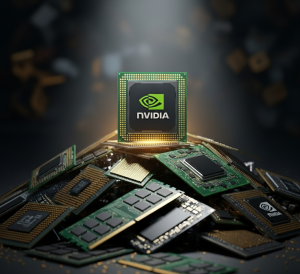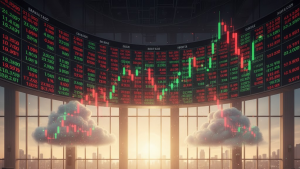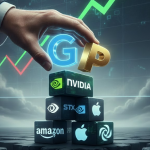The Earnings Paradox: Why a Strong Start to Q3 Couldn’t Save a Fearful Market
The U.S. stock market was caught in a violent tug-of-war on Tuesday, as a slate of blowout corporate earnings was completely overshadowed by the escalating U.S.-China tariff conflict. The session ended with a starkly split decision: the blue-chip Dow Jones Industrial Average managed a gain, while the tech-heavy Nasdaq and the benchmark S&P 500 fell, with the S&P reversing into the red in the final hour of trading.
The day’s dominant story was the market’s visceral reaction to a targeted retaliatory move by Beijing against a U.S.-linked company. This geopolitical shockwave sent investors fleeing from risk, selling high-flying tech stocks and piling into safe havens like gold. The fear proved powerful enough to render stellar earnings reports from banking giants like JPMorgan Chase and Goldman Sachs almost irrelevant, exposing a fragile market where macroeconomic anxiety is the only narrative that matters.
Tuesday’s Market Deconstructed: A Flight from Risk
The day’s trading was a textbook example of a risk-off rotation. The divergence among the major indices tells the whole story:
- The Dow Jones Industrial Average rose 0.44% (+203 points), buoyed by domestically focused stocks like Walmart (+5.0%) and Caterpillar (+4.5%).
- The S&P 500 fell 0.16% (-10 points), giving up its midday gains in a late-session fade.
- The Nasdaq Composite, with its heavy exposure to global technology, bore the brunt of the selling, dropping 0.76% (-173 points).
This split was driven by a clear investor playbook: sell companies exposed to China and buy those perceived as insulated. The semiconductor sector was hit hardest, with industry leaders Nvidia (NVDA) and Intel (INTC) falling 4.4% and 4.3%, respectively. This was a direct response to fears that an escalating trade war could cripple global tech supply chains.
The most telling signal of rising anxiety was the Cboe Volatility Index (VIX). Wall Street’s “fear gauge” spiked nearly 16% to close at 22.04, a four-month high. This surge shows investors are actively paying a premium to protect against further downside.
The flight to safety was unmistakable:
- Gold futures surged to a new record high, closing at $4,155 per ounce.
- In contrast, Bitcoin fell 1.9% to below $113,000, trading in line with speculative tech stocks rather than as a safe haven.
- The Russell 2000 index of smaller, U.S.-focused companies outperformed, gaining 1.31% as investors sought refuge from global turmoil.
The Driver: China’s “Surgical Strike” Weaponizes Supply Chains
The market’s turmoil was ignited by a precise and strategic move from Beijing. China’s Commerce Ministry sanctioned five U.S.-linked subsidiaries of a major South Korean shipbuilder, Hanwha Ocean.
This was not a broad tariff but a “surgical strike” designed to send a clear message: collaborating with Washington’s industrial policy will result in being cut off from the Chinese market. It marks a dangerous evolution in the trade conflict, moving from blunt economic pressure to the weaponization of global supply chains. The move confirmed investors’ worst fears, validating warnings from analysts that the dispute could cause a stagflationary shock to the U.S. economy by disrupting access to critical materials like rare earth minerals.
The Paradox: When Blowout Earnings Aren’t Good Enough
In any other environment, the day’s corporate news would have sparked a major rally. The third-quarter earnings season kicked off with a series of exceptionally strong reports from the banking sector.
- JPMorgan Chase (JPM) “easily beat” Wall Street estimates, with trading revenues soaring.
- Goldman Sachs (GS) announced a 37% surge in year-over-year profit, fueled by a boom in dealmaking.
- Wells Fargo (WFC) not only beat estimates but also raised its future profitability targets.
- Citigroup (C) and BlackRock (BLK) also delivered powerful results.
Yet, the market’s reaction was to sell the news. JPMorgan fell 1.9% and Goldman Sachs dropped 2.0%. The message was clear: in a market gripped by systemic risk, strong backward-looking results are heavily discounted. Investors are far more concerned with forward-looking geopolitical uncertainty than with last quarter’s profits.
The Bottom Line: A Market Flying Blind
Compounding the anxiety is a lack of clear economic data due to the ongoing government shutdown. This forces the Federal Reserve and investors to “fly blind.” The few data points available are concerning. A survey from the National Federation of Independent Business (NFIB) showed small business uncertainty surged in September to one of its highest levels on record.
This creates a dangerous disconnect. On one hand, the IMF recently upgraded its U.S. growth forecast. On the other, “Main Street” businesses are signaling deep anxiety. This suggests the market’s health is dependent on a dangerously narrow group of mega-cap tech companies the very stocks most at risk from the trade war. A recent survey highlighted this contradiction perfectly: even as investors were panic-selling on Tuesday, a new report showed long-term investor confidence had just hit a record high.
This gap between stated confidence and actual fearful behavior reveals a deep complacency, creating a vulnerability to a much sharper correction if geopolitical tensions worsen.
Predictive Outlook for October 15
The market remains on a knife’s edge, with its direction dictated by headlines from Washington and Beijing. The most critical catalyst will be earnings from semiconductor firms ASML (pre-market Wednesday) and TSM (Thursday). Their results and guidance will either calm a battered sector or confirm its worst fears.
Technically, the S&P 500 is hovering just above its 50-day moving average (approx. 6,525). A break below this key level could trigger a deeper, technically-driven sell-off. For now, expect volatility to remain high as the market weighs strong corporate fundamentals against severe and unpredictable geopolitical risk.
Disclaimer: This article is for informational purposes only and does not constitute financial, investment, or legal advice. The information provided is a synthesis of publicly available data and expert analysis and should not be considered a recommendation to buy or sell any security. Investing in the stock market involves risk, including the possible loss of principal. Past performance is not indicative of future results. Readers should consult with a qualified financial advisor to determine an investment strategy that is suitable for their own personal financial situation and risk tolerance.






















